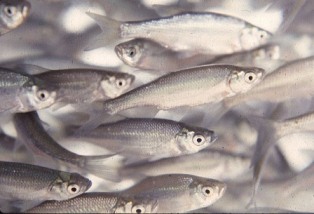Stocked alone without some forage species, largemouths usually stunt and reproduce poorly. They require other fish, such as bluegill, as food to allow for good growth and spawning. Largemouth bass should generally be stocked in late spring, the year after bream have been stocked, so adequate forage will be available to support survival and growth. In most areas, largemouth bass normally live about six to eight years if not caught by fishermen or eaten by larger fish. Although bluegill provide an abundant source of forage to support bass populations, they will overpopulate and stunt if not tightly controlled through fishing and bass predation. A serious problem occurs when bluegill become so numerous that they interfere with bass spawning and reproduction. This is more common than most pond owners realize. For this reason, pond owners should avoid excessive cover in bass-bluegill ponds, especially rooted aquatic vegetation. Whether you keep track of numbers or pounds of fish, most of the fish harvested from a bass-bream pond should be bream. A general recommendation is to harvest at least 5 pounds and as much as 10 pounds of bream for every pound of bass. In many instances, any bluegill which is caught should be removed from the pond, whether it is large enough to eat or not. Redear sunfish are not as prolific as bluegill, and may be thrown back except when bream populations are extremely high. Another point to remember is that when a bream is removed from the pond, another individual will grow to take its place within several months. When a bass is caught, however, it will take roughly one year for a younger fish to take its place. For this reason, bass harvests must be spread out over the entire fishing season if pond balance is to be maintained. One warning sign that a pond may be headed toward an overpopulation of bream that will prevent bass reproduction is the occurrence of very few or no small bass and very few or no large bream. When this condition arises, management efforts should focus on removing as many small bream as possible to allow the few large bass left in the pond an opportunity to spawn again.
